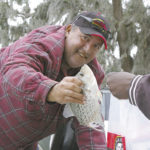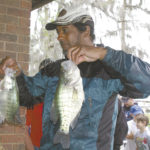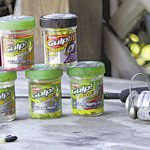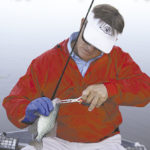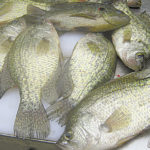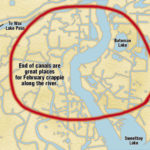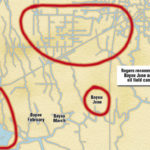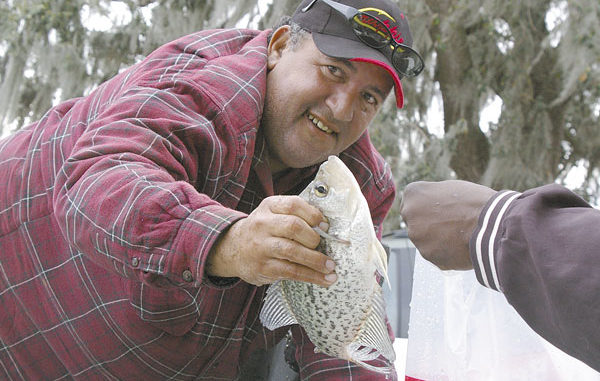
Fish these peninsula-shaped grass beds in the Basin, and you’ll feel like a victorious Crappie USA contestant.
In February 2009, for the first time in nearly 15 years, Crappie USA came back to Louisiana to hold a qualifying tournament. The area the organization selected was the Atchafalaya Basin, with Morgan City the host.
In spite of reports concerning massive fish kills as a result of Hurricane Gustav the previous fall, anglers came from afar to fish the tournament.
They came because they heard what local anglers have known for years. This central portion of the state is noted for crappie, not to mention its beauty and its people.
Though the fishing was tough as a result of Gustav’s wrath and a cold front that passed through the day of the event, there were fish caught — some approaching nearly 2 pounds.
Going into February 2010, primetime for crappie, what can anglers expect for the region? The answer could be a banner year.
No doubt, the widespread fish kill set the fishing back for the short term. However, what anglers experience a year and a half or so later is a boom.
As surviving fish move back into their old haunts to spawn, there are fewer predator fish to contend with. This reduces fish mortality.
Additionally, in 2009, local water levels remained above flood stage well into late spring and early summer. Whenever water overflows the banks in the Basin and marshes below Morgan City, it provides habitat and sanctuary for fish to spawn — again playing a key role in reducing fish mortality.
Mother Nature seems to be doing her thing; in 2010 the fish should really rebound from the fall of 2008 — though 2009 wasn’t bad. Much depends on what most fishermen already know: Water condition, high pressure and getting time away to be there when fish are biting makes all of the difference between a poor catch and a pile to clean.
Eddie Young, 64, travels from Rayne, 15 miles west of Lafayette, to the region regularly.
“I’ve been going to the area for about 25 years,” he said. “I fish it year round as conditions permit. I often fish the Basin and the marsh south of Morgan City. I’ll fish the Basin, the Wax and Belle Isle. It’s so vast of an area, you can fish 5 years without going to the same place again.”
Much has been said about vertical presentation to crappie. Young admits that when fish are feeding in a frenzy, they’ll hit just about anything fished any kind of way. But when the fish are light-biting and acting finicky, that’s when a little more finesse comes into play.
“When they’re not biting, that’s when skill takes over,” he said. “You’ve got to entice them to bite. And sometimes I’ll use an attractant — like a shad scent — when they’re deep in cover or it’s a blue-bird sky and they won’t go after natural bait. I might have to put spray on it to draw them out.”
Where the sky is concerned, Young has learned plenty fishing sac-a-lait, particularly when using artificial baits.
“What I do on dark, cloudy days is use darker bait,” he said. “On blue-bird days, I use lighter baits, like bright chartreuse. On a darker day, I’ll use black/chartreuse or violet, where you have a better silhouette. The darker the days, the darker the silhouette; the lighter the day, light baits give you a better silhouette.”
Young points out if you can catch bass, you can catch crappie.
“If you think about it, the same thing you do with bass, you can do with crappie,” he said. “Wherever there is a bass, there is a crappie around too. They are all, relatively speaking, the same species. They have the same feeding patterns. The biggest difference is a bass is more aggressive.
“What I do different is adjust my bait and its size, but the presentation is the same. The same presentation you use to catch a bass, you do the same thing with crappie. The secret about it is, wherever you catch a bass, I’m pretty sure I can catch a crappie.”
Ray Beadle, a local angler from Bayou Vista, enjoys fishing crappie with his wife Gloria, in the canals and marshes below Morgan City.
“This year it was back-to-back-to-back days where my wife and I caught them,” he said. “Most of the 2-pounders were caught by the time we got to them, so we took the ¾-pound scraps and cooked them up. My wife is hooked on swinging sac-a-lait in the boat.”
Beadle and Young use 10-foot fly rods with Pflueger ultra-light spinning reels loaded with 6-pound-test line.
“I prefer 6-pound-test Cajun red line,” Young said. “I’ll use it with what we call a pear-type cork.”
Young also uses extremely light jigs — almost fly-like — mentioning that he prefers slower-moving baits when fishing crappie.
“I use a 1/32-ounce jig,” he said. “Yes, it’s an in-between size, but the reason I use it is because it’s so life-like. It’s a whole lot slower, and sometimes you get these fish that are very lazy. Most predators are not going to expend that much energy to go after food if they have a chance of catching it.
If you throw a lighter jig in their food-chain path, then it’s like, ‘This thing is small. I stand a better chance eating it.’ With a slow presentation, the greater your chances of catching fish.”
Beadle and Young both like to fish around structure, but also what they refer to as “sprigs.” These are essentially small grass mats that form little peninsula-like points. Both anglers also look for some kind of moving water. Since all of the surrounding area is tidal, they both also prefer a falling tide.
When water moves through, around and in front of these sprigs, they both will drift their baits all around them. Strikes are regular.
When it comes to bait height, Young has perfected his skill here as well.
“The average depth of the canals I fish are 4 to 5 feet,” he said. “At certain times of the year, you can catch crappie in 6 inches of water, depending on the conditions. That’s the thing about crappie; you just can’t go out there and start throwing line.
“I rely on the depth finder quite a bit. It shows me how deep the fish are. If the water is 10 feet deep, I might set the jig below the cork at around 5 feet. There is a comfort zone fish are at or where fish should be. If that bait is above the fish above the comfort zone, they’ll come up to get it, but won’t go below that comfort zone. So I try to keep my cork and bait right at their comfort zone.”
One of the biggest things the area has to offer is people willing to help others catch fish. Young travels more than 75 miles on a regular basis to catch crappie. The traveling angler says it’s not just the quality of the fishing in the region, but the people and how courteous they are.
For the Crappie USA tournament held last February, Dallas Thomas traveled all the way from Elwood, Ind., with his fishing partner Greg Caldwell. The two friends won the semi-pro division of the Atchafalaya Basin qualifier.
“We met some nice buddies, and look forward to fishing with them again,” Thomas said. “We love it because the people here are wonderful. We drove 1,022 miles to get here, and we’d travel 1,500 to come back.”
And that was the February following a severe fall storm.
In 2010, the biological stars may be lining up for crappie anglers as the fish rebound in the central region of the state.
